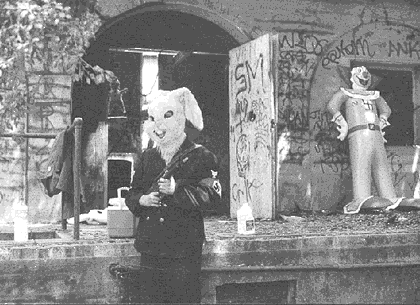
"NUTS
ARE ATTRACTED TO THIS PLACE"
(excerpt
from LA Times)
The story, which Young admits
is sketchy, centers on the owners of the Murphy Ranch, Winona and Norman
Stephens, and a mysterious but persuasive German named Herr Schmidt.
Although county records say that a Jessie M. Murphy purchased the property
in 1933, Young said there is no other record of her, and no one in the
area ever saw her, leading him to suspect Murphy was a front name.
The name Murphy Ranch, however, stuck. Norman Stephens was an engineer
with silver mining interests in Colorado, and apparently financed the operation.
His wife, the daughter of a wealthy industrialist, had a strong belief
in metaphysical phenomena, and apparently fell under the spell of Schmidt,
who claimed to have supernatural powers. Schmidt convinced the Stephenses
that once Europe collapsed and Germany emerged victorious in the war, anarchy
would break out across the country, and law and order would break down.
His plan was to create a command center in which the National Socialist
community would wait out the war. They could then emerge from their
mountain retreat and impose order on society. It apparently made sense
to the Stephenses, for they proceeded to spend an estimated $4 million
to build an infrastructure that would be enough for a small town.
They also made plans to build a four-story mansion that were never carried
out, probably because they ran out of money, Young said. What they did
accomplish, however, is amazing. The entire hillside above the ranch
was terraced, and a sprinkler system, complete with timers, was laid out
to irrigate the numerous fruit, nut, carob and olive trees and other plants
that covered it. Several concrete staircases ascend the hillside,
which were either to allow for maintenance of the trees, or more likely,
Young believes, to patrol the property. The water tank and the power
station, with its double generators, ensured that the community would be
self-sufficient. The power station is the only structure basically
intact, although the generators were removed and donated to Loyola Marymount
University in the early 1970s. The inside walls are covered with
graffiti, much of it typical of what one would find in an abandoned building,
including, ironically, several swastikas. "I think there are a lot of gangs
and skinheads who come here," Young said. "Nuts are attracted to
this place."
The only other structure
standing on the property is a two-story steel-frame building that was use>